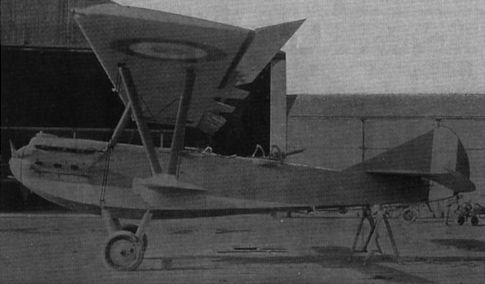
Flight, December 1926
The Paris Aero Show 1926
VILLIERS
THE exhibit of the Francois Villiers Company will consist of a Villiers type II naval two-seater fighter aeroplane (avion marin), with 450 h.p. Lorraine-Dietrich engine, and of a Villiers type V two-seater night fighter, also with 450 h.p. Lorraine-Dietrich engine.
The Villiers Type II Naval Two-Seater Fighter.- The Villiers type II naval two-seater fighter was specially designed for fighting heavy flying-boats with the advantage of incorporating the features of a landplane but having at the same time the ability of alighting safely on water. In other words, the Villiers II is a "seagoing aeroplane," which is particularly adapted to use on board aircraft carriers.
The fuselage is of the water-tight type, being constructed on the lines of a flying-boat hull, with timber framing. The wings, which are also timber-framed, are of the sesquiplane type, with Vee interplane struts. The bottom wing, which is mounted midway up the fuselage depth, carries wing tip floats. The undercarriage may be dropped by the pilot for alighting on the sea. For landing on the deck of aircraft carriers, the machine incorporates an arresting gear which engages with the transverse wires of the deck.
The petrol tank is equipped with an instantaneous emptying device, which is operated by carbonic acid contained in a bottle.
The armament consists of two synchronised Vickers guns and two Lewis guns on ring mounts.
Specification.- Engine, 450 h.p. Lorraine-Dietrich; span, 13-00 m.; length, 9-46 m.; height, 3-68 m.; wing area, 40 sq. m.; weight, empty, 1,565 kg.; fuel load, 235 kg.; useful load, 250 kg.; weight, loaded, 2,050 kg.; maximum speed, sea level, 218 km.p.h.; speed at 5,000 m. altitude, 202 km.p.h.; speed at 6,000 m. altitude, 196 km.p.h.; climb to 6,000 m. altitude, 29 mins.; theoretical ceiling, 6,250 m.
The Villiers Type V Two-Seater Night Fighter.- The Villiers type V Two-Seater Night Fighter, fitted with the 450 h.p. Lorraine-Dietrich engine, is a single-bay biplane of timber construction. The wings are fabric-covered and the interplane struts are faired duralumin tubes, which are fitted with an adjusting device for length. The cabane struts, of the diverging (outward sloping) type, are steel tubes. The fuselage is built along the lines of the Villiers type II, that is, with a water-tight hull arrangement. The engine bearers are duralumin box girders. Radiators arc of the Lamblin 1925 type. The petrol tank may be jettisoned in flight. The undercarriage is rubber sprung.
The armament consists of two fixed Vickers gun and two flexible Lewis guns. The equipment includes a heating arrangement for the armament and the crew, landing flares and searchlight, Michelin bomb release and wireless outfit.
Specification.- Engine: 450 h.p. Lorraine-Dietrich. Span: 12-00 m. Length: 8-750 m. Height: 3-300 m. Wing area : 40 sq. m. Weight, empty: 1,274 kg. Useful load: 465 kg. Fuel load: 366 kg. Weight, loaded: 2,105 kg. Maximum speed, sea level: 224 km.p.h. Speed at 4,000 m. altitude: 210 km.p.h. Min. speed: 92 km.p.h. Climb to 6,500 m.: 43 mins. Service ceiling: 7,000 m.
Two machines were exhibited by Francois Villiers, a comparative newcomer to the French aircraft industry. Of these one, the Villiers type No.II C.2, was an avion marin of the type designed to be able to alight on the sea in case of engine trouble. This machine is similar to other French machines of its class in that the undercarriage, a wood structure, is watertight so as to provide sufficient flotation to keep the machine from sinking until it can be picked up. The bottom plane, which is of smaller span and chord than the top plane, is attached to the watertight fuselage approximately halfway up the sides, or roughly at the level of the water line, and two wing tip floats provide lateral stability when the machine is at rest on the water. The undercarriage can be dropped before alighting in the sea, the propeller being locked in a horizontal position. The machine is otherwise of orthodox design, the only unusual feature being necessitated by the purpose for which the machine was designed. Owing to the raising of the bottom plane up to the centre line of the fuselage, the top plane is placed very high in relation to the body, doubtless in order to retain a good gap/chord ratio.
The other machine exhibited was a type V, two-seater night fighter equipped with landing lights and other equipment necessary to its function. In place of the Vee interplane struts of the avion marin the type V had single "I" struts built up of rectangular section duralumin tubes faired with sheet aluminium, and provided with incidence adjustment in the form of short rods from the main tube to the two wing spars. The machine is of normal construction, with ply-wood covered fuselage and wood wing spars and ribs. It is a clean-looking job and is credited with a top speed at ground level of 224 km./h. (139 m.p.h.).
- Flight, December 1926
The Paris Aero Show 1926
Фотографии
-
Air International 1995-09 / Fighter A to Z
The Villiers II was unusual in having a watertight hull-type fuselage to allow it to alight on water in emergency.
-
Flight 1926-12 / Flight
The Villiers Type II, 450 h.p. Lorraine, is a landplane capable of floating after a descent on the sea. It then has to be hoisted on board a vessel.
-
Flight 1926-12 / Flight
The Villiers ''Avion Marin'' has a very small bottom 'plane. Note the wing tip float and the Lamblin radiator on the leading edge. The undercarriage can be dropped, part of the release gear being visible in this sketch.
-
Air International 1995-09 / Fighter A to Z
The Villiers V, a two-seat night fighter, was tested in 1926.
- Фотографии




